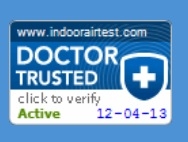News
Understanding Indoor Air Quality (IAQ)
The term "indoor air quality" (IAQ), interpreted broadly, refers to the environmental characteristics inside buildings that may affect human health, comfort, or work performance.
The term "indoor air quality" (IAQ), interpreted broadly, refers to the environmental characteristics inside buildings that may affect human health, comfort, or work performance. IAQ characteristics include the concentrations of (amounts of) pollutants in indoor air, as well as air temperature and humidity. Concentrations of pollutants on indoor surfaces that may be contacted by people, and indoor lighting and acoustic (noise) conditions are also often considered aspects of IAQ. Sometimes, the rate of outdoor air supply to a building, i.e., the ventilation rate, is treated as an IAQ condition because of the ventilation rate has a strong influence on the concentration of many indoor air pollutants.
For an air pollutant, the "concentration" is the amount of pollutant present in each unit volume (e.g., cubic foot or cubic meter) or unit mass (e.g., pound or kilogram) of air. The term "exposure" usually refers to the product of pollutant concentration in the breathing zone of a space and time the person spends in the space, often summed for all spaces encountered to estimate total exposure. Exposure determines the amount of pollutant that is inhaled. The product of time spent indoors and average indoor air pollutant concentration is an often-used estimate of indoor exposure. Because people who live in developed countries are indoors approximately 90% of the time, their exposures to most indoor-generated and outdoor air pollutants are dominated by indoor exposures. For some indoor-generated pollutants, e.g., some of the chemicals emitted by indoor materials or by consumer products used indoors, outdoor exposures are negligible compared to indoor exposures.
IAQ can affect people's comfort, health, and work and schoolwork performance. Aspects of comfort affected by IAQ include thermal comfort and olfactory or sensory comfort, where the latter is often indicated by the level of acceptability of indoor air. A broad range of health effects may result from indoor pollutant exposures. Some pollutants increase the risk of cancers or other very serious health effects. Some indoor pollutants can infect people and cause infectious disease such as the common cold or influenza. Allergy or asthma symptoms may result from indoor pollutant exposures. Also, indoor pollutants may contribute to eye, nose or throat irritation, skin irritation, cough, wheeze, headache, and fatigue symptoms which are often called sick building syndrome (SBS) symptoms or building related symptoms (BRS).
When people are indoors, they are exposed to air pollutants generated from indoor sources and to air pollutants that enter the building with outdoor air. Examples of indoor-generated air pollutants include gases and particles produced by tobacco smoking, particles and gases released by molds and bacteria that grow indoors on damp surfaces, and the volatile organic compounds (gaseous chemicals containing carbon and hydrogen and often other elements) emitted by some building products, furnishings, and consumer products. People are also sources of indoor air pollutants, for example, odorous gases. Ozone, a reactive gaseous constituent of outdoor air pollution, and various types of very small invisible particles are examples of outdoor air pollutants that enter buildings with outdoor air.
IAQ conditions depend upon the design, construction, maintenance, and operation of a building and on the outdoor environmental conditions. People and their activities also affect IAQ conditions. Indoor pollutant concentrations depend primarily on outdoor concentrations, on the rates of pollutant emissions from various indoor sources, and on the rates at which pollutants are removed from indoors by ventilation with outdoor air, filtration, and natural processes such as pollutant deposition from air onto surfaces. Examples of indoor pollutant sources include building materials, furnishings, equipment, cleaning and pest control products, pets, molds, bacteria, and people and their activities such as tobacco smoking and cooking. The main factors affecting indoor thermal comfort are indoor air temperatures, the temperatures of exterior walls and windows, humidity, and the amount of indoor air motion. Thermal comfort is also affected by the activity level and by clothing of the occupants. Individual thermal comfort preferences vary. The design of the building's envelope, the design and operation of the building's heating and air conditioning systems, and the outdoor temperature and humidity are key determinants of thermal comfort. Indoor lighting and acoustic conditions similarly depend on multiple features of the building and on occupant activities.
Pure Air Control Services, Inc. (PACS) provides guidance for these concerns. Assessment results and visual observations are documented and explained in terms of their affect on the buildings indoor air and occupants.
PACS can perform environmental sampling, mechanical hygiene evaluations, thermography, blower door analysis, duct leakage analysis and building pressure analysis to get a picture of how the indoor environment is being affected by the building and its components. PACS will follow up on all reported complaints. Using the results from the assays performed, PACS will then explain how these results relate to the occupant complaints along with clear and concise conclusions regarding what is happening in the indoor environment. PACS then gives precise and concrete recommendations to address the occupants and building managers’ concerns.
For a professional IAQ Assessment of your building or home, please call William Radu or Alan Wozniak at 800-422-7873 ext. 202 or 802 respectively.
About Pure Air Control Services:
Founded in 1984 by Alan Wozniak, President/CEO in what began as a small mechanical contracting business has grown into an award winning, industry leading indoor air quality (IAQ) service company serving many fortune 500 corporations, school boards, county, city, state and federal governments and consumers across the US. The firm has serviced over 600 million square feet of indoor environments in over 10,000 facilities.
Pure Air’s nationally performed services include: Building Sciences Evaluation; Building Health Check; an AIHA accredited Environmental Microbiology Laboratory; Environmental Project Management; and Duct Cleaning & Mold Remediation Services, among other indoor environmental services. The company’s expanding client roster includes the General Services Administration (GSA); Federal Aviation Administration (FAA), Allstate Insurance; Carrier Air Conditioning; Naval Air Warfare Center, Orlando; and Naval Air Station - King's Bay, Georgia, and many other Fortune 500 companies, school boards, and city, state, and county governments, making Pure Air a reliable industry leader For more information, visit the company’s web site at www.pureaircontrols.com or contact Alan Wozniak at 1-800-422-PURE (7873) ext 802.

More News

IAQ Test Kits (DIY), PURE-Steam Coil Cleaning and PURE-Decon Room Treatment Showcased at the Annual FRACCA Conference
This annual event provides an opportunity for licensed contractors throughout the State of Florida to obtain all 14 state-required hours of continuing education over the course of the two-day event.
Released On: 3/8/2014
Views: 4346

Free Legionella Webinar: Detection & Identification Workshop
Although this type of bacteria was around before1976, more illness from Legionnaires' disease is being detected now. Due to consumer awareness, added research and technological advances in healthcare Legionnaires disease identification is becomi ...
Released On: 3/4/2014
Views: 4201

Why Some High-Performance Buildings Are Failing?
Performance of a building depends on its structured integrity, preventive maintenance, as well as periodical monitoring of the environmental conditions essential for its functionality.
Released On: 2/19/2014
Views: 4231

Legionnaire’s – What You Should Know About The Potential Deadly Bacteria
According to Building Operating Management magazine, expert Victor Yu, MD, Professor of Medicine, University of Pittsburgh; Chief, Infectious Disease Section, VA Medical Center, Pittsburgh, PA, disclosed that “Up to 70% of all buildings greater t ...
Released On: 2/18/2014
Views: 3788

Managing of Indoor Environments: Problems and Solutions - IEQ WEBINAR
Released On: 1/22/2014
Views: 3686

Save Energy and Improve Indoor Air Quality (IAQ) with PURE-Steam Deep Coil Cleaning
High efficiency coils are extremely susceptible to blockage from dust accumulation because once lodged deeply within the fins bacteria and mold may initiate growth, which not only compounds the blockage problems but also gives rise to excessive o ...
Released On: 1/8/2014
Views: 6462

January is National Radon Action Month
Exposure to radon is the second leading cause of lung cancer after smoking. Radon is an odorless, tasteless and invisible gas produced by the decay of naturally occurring uranium in soil and water.
Released On: 1/8/2014
Views: 4127

Why indoor air quality is important to all of us?
World Health Organization (WHO Guidelines for Indoor Air Quality, 2009) concluded that the most important effect is increased prevalence of respiratory symptoms, allergies and asthma, as well as perturbation of the immunological systems
Released On: 12/31/2013
Views: 4175

Pure Air Control Services Launches New Interactive Website
The website is a true indoor environmental resource for the private and public sector including consumers, educational facilities e.g. schools, universities, along with city, county state and federal governments, healthcare and the public sector.
Released On: 12/20/2013
Views: 3179

Pure Air Control Services Awarded Certification from Doctor Trusted
“We are very proud to have been given the opportunity to display that we are a Doctor Trusted recipient. We will continue as always to help provide our customers with a great products and services,” stated Dr. Rajiv Sahay, environmental analytica ...
Released On: 12/11/2013
Views: 4122

IndoorAirTest.com Receives Seal of Approval by Doctor Trusted
IndoorAirtest.com is very proud to have a Doctor Trusted seal of approval displayed on our website, giving our customers more confidence when shopping with us.
Released On: 12/4/2013
Views: 4550

PURE-Decon/Sanosil, Reduces Sick Days Caused by Infection
Released On: 10/2/2013
Views: 3474

Controlling Asthma & Allergy Triggers Through Source Identification
The assessment of allergens in a house dust sample is an essential step for allergen-avoidance and provides information essential for allergen-reducing measures, in addition to managing the indoor environment from a health and hygiene point of view
Released On: 9/18/2013
Views: 5569

Hospitals Get a “Clean Bill of Health” with Innovative IAQ/Energy Solutions
Healthcare-associated infections (HAIs) are infections that patients acquire during the course of receiving healthcare treatment for other conditions.
Released On: 7/31/2013
Views: 4594

How Safe is Formaldehyde in our Buildings and Homes?
Released On: 7/17/2013
Views: 4865

Commercial Energy Solutions Seminar July 26, 2013
Released On: 7/11/2013
Views: 4926

Health Risks Associated With Indoor Microbes
Some common and frequently reported microbes of the indoor environment include, but are not limited to, viruses, bacteria, mycoplasma, mold (fungi), yeast, protozoa, etc.
Released On: 6/26/2013
Views: 6078

Aspergillosis: A Cause for Indoor Concerns?
In indoor environments, this fungus can be transported from outside or may propagate on building materials such as cellulose rich sheet rocks, etc. and can generally be isolated from floors, carpets, mattress dust, Heating Ventilation Air Conditi ...
Released On: 6/19/2013
Views: 10782

Map
Pure Air Control, Services, Inc.
Get DirectionsPure Air Control, Services, Inc.
-
4911 Creekside Drive
Clearwater, Florida 33760
United States - 1 (800) 422-7873


